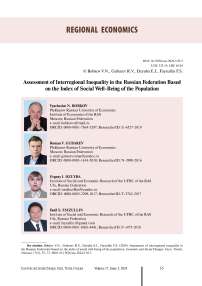Assessment of interregional inequality in the Russian Federation based on the index of social well-being of the population
Автор: Bobkov V.N., Gubarev R.V., Dzyuba E.I., Fayzullin F.S.
Журнал: Economic and Social Changes: Facts, Trends, Forecast @volnc-esc-en
Рубрика: Regional economy
Статья в выпуске: 5 т.17, 2024 года.
Бесплатный доступ
As part of this study, the goal was to develop adequate (high-precision) tools that would allow for not only a retrospective, but also a prospective assessment of interregional inequality in living standards in the Russian Federation based on the index of social well-being of the population, which is the result of a convolution of private indices. At first, a hypothesis was put forward about the possibility of building an adequate prognostic (traditional econometric) model of dependence of per capita average monetary incomes of the population on a group of factors. The information base of the study was exclusively official data of regional statistics for 2020-2022. In the course of empirical research (correlation and regression analysis), three econometric models differing in the number of factors (from 2 to 4) were developed. However, they allow (according to the average approximation error, taking values from the interval from 8.8 to 9.6 % for different econometric models) approximating regional statistics data only with an acceptable degree of accuracy. Next, a similar hypothesis was tested, but involving the use of a different tool (index method in combination with artificial intelligence), which makes it possible to measure the dependence of the population’s standard of living on a group of factors. In the course of neuromodelling it was found that any of the 5 artificial neural networks included in the Bayesian ensemble allowed approximating the regional statistics data with a high degree of accuracy (with an average error from 2.8 to 3.9 %). Thus, the second hypothesis can be considered confirmed. As part of the study, the predictive function was implemented by forming a Bayesian ensemble of artificial neural networks. The obtained results of the empirical study can act as a scientific basis for adjusting (updating) the socio-economic policy of regulating the quality and standard of living of the population and its interregional inequality among the constituent entities of the Russian Federation.
Regions of Russia, interregional inequality, standard of living, cash income, index method, correlation-regression analysis, artificial intelligence, forecasting
Короткий адрес: https://sciup.org/147245884
IDR: 147245884 | УДК: 332.14 | DOI: 10.15838/esc.2024.5.95.3
Список литературы Assessment of interregional inequality in the Russian Federation based on the index of social well-being of the population
- Bobkov V.N., Gulyugina A.A. (2023). Monitoring dokhodov i urovnya zhizni naseleniya Rossii – 2022 god. Vypusk 1 (202) [Monitoring of Incomes and Living Standards of Russia’s Population – 2022. Issue 1 (202)]. Moscow: IE RAN.
- Bobkov V.N., Odintsova E.V. (2020). Social inequality in Russia. Zhurnal Novoi ekonomicheskoi assotsiatsii=Journal of the New Economic Association, 3, 179–184. DOI: 10.31737/2221-2264-2020-47-3-8 (in Russian).
- Breiman L. (2001). Random Forests. Machine Learning, 45(1), 5–32. DOI: 10.1023/ A:1010933404324
- Chernysh M.F. (2021). The institutional foundations of inequality in modern society. Mir Rossii=Universe of Russia, 3, 6–28. DOI: 10.17323/1811-038X-2021-30-3-6-28 (in Russian).
- Dorofeev M.L. (2021). The current problem of the US government debt in the context of socioeconomic inequality regulation. Vestnik Tomskogo gosudarstvennogo universiteta. Ekonomika, 54, 273–286. DOI: 10.17223/19988648/54/16 (in Russian).
- Fleming M. (1952). A cardinal Concept of Welfare. The American Economic Review, XLI, 287.
- Ibragimova Z.F., Frants M.V. (2020). Inequality of opportunity: Theory and practice of measurement using RLMS-HSE microdata. Ekonomicheskaya politika=Economic Policy, 1, 64–89. DOI: 10.18288/1994-5124-2020-1-64-89 (in Russian).
- Jin N., Yang F., Mo Yu. et al. (2022). Highly accurate energy consumption forecasting model based on parallel LSTM neural networks. Advanced Engineering Informatics, 51, 101442. DOI: 10.1016/j.aei.2021.101442
- Lapin N.I., Ilyin V.A., Morev M.V. (2020). Extreme inequalities and the social state (part 1). Sotsiologicheskie issledovaniya, 1, 4–17. DOI:10.31857/S013216250008378-8 (in Russian).
- Leonidova G.V., Basova E.A., Rassadina M.N. (2022). Cluster analysis of income inequality of the Russian population. Problemy razvitiya territorii=Problems of Territory's Development, 6, 94–114. DOI: 10.15838/ptd.2022.6.122.6 (in Russian).
- Merzlyakov A.A., Bogdanov V.S. (2022). On the study of sociological and managerial aspects of the regulation of social inequalities in the regions of Russia. Vestnik instituta sotziologii, 4, 130–143. DOI: 10.19181/vis.2022.13.4.853 (in Russian).
- Pugachev A.A. (2023). Economic inequality of citizens beyond averages: Assessment in the conditions of its transformation. Ekonomicheskie i sotsial'nye peremeny: fakty, tendentsii, prognoz=Economic and Social Changes: Facts, Trends, Forecast, 16(3), 141–158. DOI: 10.15838/esc.2023.3.87.7 (in Russian).
- Qiu J., Wang B., Zhou C. (2019). Forecasting stock prices with long-short term memory neural network based on attention mechanism. PLoS ONE, 2.15(1): e0227222. DOI: https://doi.org/10.1371/journal.pone.0227222
- Shatalova O.M., Kasatkina E.V. (2022). Socio-economic inequality of regions in the Russian Federation: Measurement issues and long-term evaluation. Ekonomicheskie i sotsial'nye peremeny: fakty, tendentsii, prognoz=Economic and Social Changes: Facts, Trends, Forecast, 15(4), 74–87. DOI: 10.15838/esc.2022.4.82.5 (in Russian).
- Shetty P., Singh S. (2021). Hierarchical clustering: A survey. International Journal of Applied Research, 7(40), 178–181. DOI: 10.22271/allresearch.2021.v7.i4c.8484
- Simionesku M., Krivokora E., Fursov V., Astakhova E. (2020). Labor capacity building in Russian regions: Effects of regional differentiation. Terra Economicus. № 2. S. 117–138. DOI: 10.18522/2073-6606- 2020-18-2-117-138 (in Russian).
- Spiridonov A.Yu., Naidenova A.A. (2024). Quality of life: Approaches to definition, data collection system and assessment techniques. Ekonomika truda, 8, 1159–1180. DOI: 10.18334/et.11.8.121438 (in Russian).
- Surinov A.E., Luppov A.B. (2022). Income inequality and the cost of living at the sub-regional level. Estimates for Russia. Ekonomicheskii zhurnal VShE, 4, 552–578. DOI: 10.17323/1813-8691-2022-26-4-552-578 (in Russian).
- Zarova E.V., Dubravskaya E.I. (2020). The Random Forest Method in research of impact of macroeconomic indicators of regional development on informal employment rate. Voprosy statistiki, 6, 37–55. DOI: 10.34023/2313-6383-2020-27-6-37-55 (in Russian).
- Zhang Q., Abdullah A.R., Chong C.W., Ali M.H.A. (2022). Study on regional GDP forecasting analysis based on Radial Basis Function Neural Network with Genetic Algorithm (RBFNN-GA) for Shandong economy. Computational Intelligence and Neuroscience, 12. DOI: 10.1155/2022/823530
- Zhitin D.V., Prokofev A.D. (2022). Ethno-territorial features of social inequality in the USA. Vestnik Sankt-Peterburgskogo universiteta. Nauki o zemle, 2, 333–359. DOI: 10.21638/spbu07.2022.207 (in Russian).


